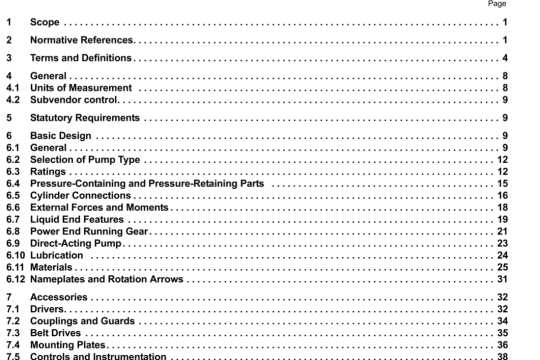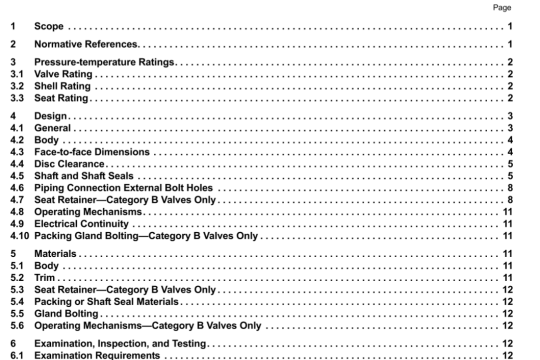API MPMS 12.3:1996(2006) pdf download
API MPMS 12.3:1996(2006) pdf download.Manual of Petroleum Measurement Standards Chapter 12-Calculation of Petroleum Quantities Section 3-Volumetric Shrinkage Resulting From Blending Light HydrocarbonsWith Crude Oils.
The majority of the available data covering blends of light and heavy hydrocarbons indicates that the change in volume is a shrinkage. However, there are ample data in the work by Booker. showing espansion of certain mixtures of crude oils with light hydrocarbons. Similar diversity an behavior is observed in mixtures of two and three pure components, as documented in the review by Hattmo.3 These results were excluded from the database used to derive this new correlation, because they cannot be predicted simply on the basis of density. Also, because there are few data available showing the variation of shrinkage with temperature and pressure, these variables have been ignored in deriving the new equation. Therefore, it is recommended that the correlation be used only for predictions near 15°C (60°F) and between 100 kilopascals (15 pounds per squire inch absolute) and 700 kilo. pascals (115 pounds per square inch absolute), since the data were obtained under these conditions.
For situations where there may be a doubt about the applicability of the new equation or tables, it is recommended chat one of the test methods discussed in Appendix C be used to provide the best possible analysis for a specific application.
1 Scope
This standard provides a procedure to quantify the volume shrinkage that occurs when blending lighter hydrocMbons (580-890 kilograms per cubic meter, 112—27 degrees API) with crude oils (644-979 kilograms per cubic meter. 88-13 degrees API). Shrinkage factors are computed from the standard densities of the hydrocarbon and the crude oil (in either International System of Units FSIJ or customary units) and the volume fraction of the hydrocarbon. The standard also recommends precautions when using the tables and provides guidance about the range of components it covers.
The purpose of this standard is to provide a procedure to quantify the volume reduction that occurs when mixing hydrocarbons of different density or API gravity. The standard provides shrinkage factors related to inverse density (mcthc system) or gravity (customary system) differentials for blends of 0 to 100 percent light with heavy hydrocarbons. The tables are entered with density differentials of Standard conditions and percentage light hydrocarbon in total mix.
At first, enlarging the shrinkage database with laboratoiy tests was considered but the estimated costs were prohibitive. As an alternate solution. an extensive literature search was undertaken, which is sumnianzed below. The literature search resulted in a selection of shrinkage infonnation from four main sources, which pros ided a wider database coveting essentially die fuLl range of 0 to 100 percent concentrations of light in heasy hydrocarbon mixes.
Robinson,6 in his work, proposed a spiked crude density prediction method based on the COSTALD7 equation. However, any theoretical advantages were lost because the five COSTALI) parameters (critical temperature. critical pressure. acenthc factor, characteristic volume, and molecular weight) were coerelated as a functron of crude oil density at 15°C. Also, Booker’ determined that the Robinson approach does not perform as well as the APT 2509C procedure.
measured volumetric shrinkage for a wide variety of Western Europe crude/condensale/producl mixtures. He noted that a density-difference-based correlation could not explain all volumetric shrinkage (or expansion). However, the overall trend of his data does support the use of density difference as a coerelarmg parameter.
Booker measured volumetric shrinkage data for seven cruder (two North Sea, one Dorset, and four African) spiked with six light paraffinic mixtures (boiling ranges of 30-40°C to 120-160°C). n-heptane, cyclohex.ane. tolucrie. and Lucini condensate. Ashcrofi, Booker. and Tumcr correlated Booker’s light paraflinic voiwne shrinkage data usmg Equation I modified to predict zero shrinkage at a 100 percent spike. Interestingly, all of Booker’s crude samples expanded when spiked with toluene or cyclohexane. and some crudes expanded when spiked with heavier par-aflinic mixtures.
Equation I was modified to predict zero shrinkage at a 100 percent spike as suggested by Ashcroft, Booker. and Turner and presented to the API Volumethc Shrinkage Committee. Shrinkage was correlated as percent of total volume. The ranges of density of oil and light hydrocarbon are given in Table I. More complete information on the data sets is given in Appendix B.




